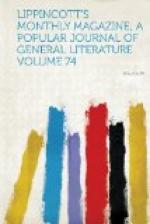Beside the deep and silent waters of the James River in Virginia, undisturbed by any sound save the flight of birds and the rustle of leaves, stands all that is left of the first church building erected by Englishmen in America. A good part of the tower remains, the arched doorways being still intact, and it seems a pitiable misfortune that the honestly-laid bricks of the venerable building could not have come down to our day. But, as it is, this ancient square block of brick forms our one pre-eminent American ruin. Nothing could be a more solemn monument of the past than the lonely tower, surrounded by thick branches and underbrush and looking down upon the few crumbling gravestones still left at its base. Jamestown, long abandoned as a village, has now become an island, the action of the waters having at last denied it the remaining solace of connection with the mainland of the Old Dominion, of whose broad acres it was once the chief town and the seat of government—the forerunner of all that came to America at the hands of English settlers.
In the slumberous old city of Williamsburg, three miles from Jamestown, stands the Bruton parish church, two hundred and two years old, and still the home of a parish of sixty communicants. Built of brick, with small-paned windows and wooden tower, its walls have listened to the eloquence of the learned presidents of the neighboring William and Mary College, and its floor has been honored by the stately tread of many a colonial governor, member of the legislature or Revolutionary patriot; for Williamsburg was the capital and centre of Virginia until the end of the eighteenth century, and shared whatever Virginia possessed of political or personal renown. Washington, of course, was more than once an attendant at Bruton Church, and so were Jefferson and Patrick Henry and an honorable host. In the church and in the chapel of William and Mary College—which the ambitious colonists used to think a little Westminster Abbey—was the religious home of a good share of what was stateliest or most honorable in the early colonial life of the South.
Other old churches still dot the Virginia soil—St. John’s, Richmond; Pohick Church, Westmoreland county; Christ Church, Lancaster county; St. Anne’s, Isle of Wight county. Their antiquities, and those of other ancient sanctuaries of the Old Dominion, have been painstakingly set forth by Bishop Meade and other zealous chroniclers, and their attractiveness is increased, in most cases—as at Jamestown—by the loneliness of their surroundings. Another old church, left in the midst of sweet country sights and gentle country sounds, is St. James’s, Goose Creek, South Carolina. St. Michael’s and St. Philip’s at Charleston in the same State have heard the roar of hostile cannon, but have come forth unscathed. The demolished Brattle Street Church in Boston was not the only one of our sacred edifices to be wounded by cannonballs, for the exigences of the fight more than once, during the Revolution and the civil war, brought flame and destruction within the altar-rails of churches North and South.




